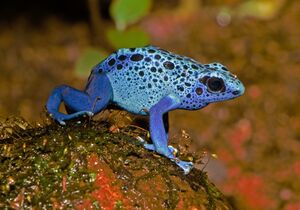علم البرمائيات والزواحف
علم البرمائيات والزواحف ( Herpetology من الكلمة اليونانية ἑρπετόν herpetón، وتعني "زواحف" أو "حيوان زاحف") هو فرع من علم الحيوان يتعلق بدراسة البرمائيات (including frogs, toads, salamanders, newts, and caecilians (gymnophiona)) والزواحف (including snakes, lizards, amphisbaenids, turtles, terrapins, tortoises, crocodilians, and tuataras).[1][2][3] Birds, which are cladistically included within Reptilia, are traditionally excluded here; the separate scientific study of birds is the subject of ornithology.[4]
The definition of herpetology can be more precisely stated as the study of ectothermic (cold-blooded) tetrapods. This definition of "herps" (otherwise called "herptiles" or "herpetofauna") excludes fish; however, it is not uncommon for herpetological and ichthyological scientific societies to collaborate. For instance, groups such as the American Society of Ichthyologists and Herpetologists have co-published journals and hosts conferences to foster the exchange of ideas between the fields.[5] Herpetological societies are formed to promote interest in reptiles and amphibians, both captive and wild.
Herpetological studies can offer benefits relevant to humanity-centric fields by researching the role of amphibians and reptiles in global ecology. For example, by monitoring amphibians that are very sensitive to environmental changes, herpetologists record visible warnings that significant climate changes are taking place.[6][7] Although they can be deadly, some toxins and venoms produced by reptiles and amphibians are useful in human medicine. Currently, some snake venom has been used to create anti-coagulants that work to treat strokes and heart attacks.[8]
التسمية وأصل الاسم
The word herpetology is from Greek: ἑρπετόν, herpetón, "creeping animal" and -λογία, -logia, "knowledge".
"Herp" is a vernacular term for non-avian reptiles and amphibians. It is derived from the old term "herpetile", with roots back to Linnaeus's classification of animals, in which he grouped reptiles and amphibians in the same class. There are over 6700 species of amphibians[9] and over 9000 species of reptiles.[10] Despite its modern taxonomic irrelevance, the term has persisted, particularly in the names of herpetology, the scientific study of non-avian reptiles and amphibians, and herpetoculture, the captive care and breeding of reptiles and amphibians.
التاريخ
القرن السابع عشر
في القرن السابع عشر، numerous works attempted to better understand the location of venom in the heads of snakes , and in particular vipers , as well as its mode of action. Of course, this research carried out by doctors also has the function of discovering an antidote . Among these scientists, two names stand out during this century.
- فرانسسكو ردي Francesco Redi (1626-1697) considerably advanced knowledge, notably by affirming the harmlessness of the venom if it was ingested.
- مواز شاراس Moyse Charas (1619-1698), pharmacist at the Jardin du Roi , carried out numerous experiments and published numerous works on vipers. He disagrees with Redi on the subject of venom formation by asserting that the viper's saliva only becomes venomous if the animal is angry.
- جون راي John Ray (1627-1705) discovered that the one-ventricle heart is a distinctive feature of Reptiles among the Vertebrates possessing lungs.
- دوڤرني Duverney (1648-1730) published several important memoirs at the beginning of the 18th century before the Paris Academy of Sciences on the circulatory and respiratory systems of cold-blooded vertebrates such as frogs, snakes, etc. 1 .
The existence of external fertilization in amphibians was anticipated in 1736 by Réaumur (1683-1757): he attached “breeches” to male frogs to try to prevent possible fertilization, but the experiment was not conclusive. .
The term "herpetology" was created by Klein in 1755. Among the works of Klein ( 1685-1759), we can cite in particular Summa Dubiorum Circa Classes Quadrupedum et Amphibiorum (1743) and Tentamen Herpetologiae (1755). It is in this work that he uses, for the first time, the term herpetology but his delimitation of reptiles is still vague since he groups with them animals such as worms and excludes frogs , turtles and lizards . . Its definition is thus formulated: “ Herpeta sunt animantia apeda, corpore elongata, quod volutum et flexuose loco malium movetur et sinuosum quiescit : The Herpeta or legless and crawling animals are divided into two orders: the Anguis , which includes all snakes and reptiles without legs and the Vermis which brings together all the worms. » 2
القرن الثامن عشر
في القرن الثامن عشر، يوسفوس نيكولاوس لورنتي Josephus Nicolaus Laurenti (1735-1805) was the great name in the discipline. In 1768 he published his thesis devoted to the venomous function in reptiles and amphibians . In addition to valuable observations on venom, he considerably improved the Linnaean taxonomy , which went from ten genera of reptiles and amphibians to thirty. Laurenti was the first to precisely define the class Reptilia .
رسام الحيوانات روزل Roesel (1705-1759) نشر بين 1753 و 1758 كتابه Historia naturalis Ranarum nostratium devoted to frogs . The qualities of the work, particularly its illustrations, make it considered one of the most beautiful devoted to these animals.
بيّن مدير الدير لازارو سپالانزاني Spallanzani (1729-1799) أن حيوانات معينة، خصوصاً السحالي، يمكنها regenerate certain parts of their body when they have been injured or severed. Spallanzani also carried out experimental work on animal reproduction which led to the discovery of external fertilization in frogs and toads.
Lacépède (1756-1825) published, in 1788 - 1789 , his Natural History of Oviparous Quadrupeds and Serpents . This is the first major work on amphibians and reptiles intended for a wide audience. But his illustrations are mediocre and his book does not improve the taxonomy of these animals. Laurenti's work, although older, is much superior. Despite these flaws, Lacépède's work contributes to promoting the study of these animals.
المجالات الفرعية
The field of herpetology can be divided into areas dealing with particular taxonomic groups such as frogs (batrachology),[11][12] snakes (ophiology or ophidiology), lizards (saurology) and turtles (cheloniology, chelonology, or testudinology).[13][14]
More generally, herpetologists work on functional problems in the ecology, evolution, physiology, behavior, taxonomy, or molecular biology, of amphibians and reptiles. Amphibians or reptiles can be used as model organisms for specific questions in these fields, such as the role of frogs in the ecology of a wetland. All of these areas are related through their evolutionary history, an example being the evolution of viviparity (including behavior and reproduction).[15]
التخصص
Career options in the field of herpetology include lab research, field studies and surveys, assistance in veterinary and medical procedures, zoological staff, museum staff, and college teaching.[16]
In modern academic science, it is rare for individuals to consider themselves a herpetologist first and foremost. Most individuals focus on a particular field such as ecology, evolution, taxonomy, physiology, or molecular biology, and within that field ask questions pertaining to or best answered by examining reptiles and amphibians. For example, an evolutionary biologist who is also a herpetologist may choose to work on an issue such as the evolution of warning coloration in coral snakes.[17]
Modern herpetological writers include Mark O'Shea[18] and Philip Purser. Modern herpetological showmen include Jeff Corwin, Steve Irwin (popularly known as the "Crocodile Hunter"), and Austin Stevens, popularly known as "Austin Snakeman" in the TV series Austin Stevens: Snakemaster.
Herpetology is an established hobby around the world due to the varied biodiversity in many environments. Many amateur herpetologists coin themselves "herpers".[19]
الدراسة
Most colleges or universities do not offer a major in herpetology at the undergraduate or the graduate level. Instead, persons interested in herpetology select a major in the biological sciences. The knowledge learned about all aspects of the biology of animals is then applied to an individual study of herpetology.[20]
الدوريات
Herpetology research is published in academic journals including Ichthyology & Herpetology, founded in 1913[21] (under the name Copeia in honour of Edward Drinker Cope); Herpetologica, founded in 1936;[22] Reptiles and amphibians, founded in 1990;[23] and Contemporary Herpetology, founded in 1997 and stopped publishing in 2008.[24]
انظر أيضاً
المراجع
- ^ "Herpetology - Latest research and news - Nature". www.nature.com. Retrieved 2020-09-10.
- ^ "Herpetology - Reptiles, Amphibians, Conservation - Britannica". www.britannica.com (in الإنجليزية). Retrieved 2023-11-24.
- ^ "Herpetology - Latest research and news - Nature". www.nature.com. Retrieved 2023-11-24.
- ^ "Ornithology - Bird Identification, Behavior & Conservation - Britannica". www.britannica.com (in الإنجليزية). Retrieved 2023-09-06.
- ^ "Recent Meetings". American Society of Ichthyologists and Herptetologists (in الإنجليزية الأمريكية). Retrieved 2023-09-06.
- ^ "Why are amphibian populations declining? - U.S. Geological Survey". www.usgs.gov. Retrieved 2023-09-06.
- ^ "Amphibians as indicators of environmental health". Amphibian Ark (in الإنجليزية الأمريكية). Retrieved 2023-09-27.
- ^ "How venoms are shaping medical advances - BBC Earth". www.bbcearth.com (in الإنجليزية). Retrieved 2023-09-06.
- ^ "AmphibiaWeb". AmphibiaWeb. Retrieved 2012-08-13.
- ^ "Species Statistics February 2012". Reptile-database.org. Retrieved 2012-08-13.
- ^ D.C. Wareham (2005). Elsevier's Dictionary of Herpetological and Related Terminology. Elsevier. ISBN 978-0-08-046017-8.
- ^ Francesco M. Angelici (2015). Problematic Wildlife: A Cross-Disciplinary Approach. Springer. pp. 584–585. ISBN 978-3-319-22246-2.
- ^ Rhodin, Anders G. J. (2 August 2017). "Turtles of the World: Annotated Checklist and Atlas of Taxonomy, Synonymy, Distribution, and Conservation Status (8th Ed.)". Chelonian Research Foundation and Turtle Conservancy – via Academia.edu.
- ^ Inger, Robert F. (1992). "A Bimodal Feeding System in a Stream-Dwelling Larva of Rhacophorus from Borneo". Copeia. 1992 (3): 887–890. doi:10.2307/1446167. ISSN 0045-8511.
- ^ Blackburn, Daniel G. (December 2006). "Squamate Reptiles as Model Organisms for the Evolution of Viviparity". Herpetological Monographs. 20 (1): 131–146. doi:10.1655/0733-1347(2007)20[131:SRAMOF]2.0.CO;2. ISSN 0733-1347. S2CID 86044099.
- ^ "Herpetologist Job Description [Updated for 2023]". www.indeed.com (in الإنجليزية الأمريكية). Retrieved 2023-09-06.
- ^ Rojas, Bibiana; Valkonen, Janne; Nokelainen, Ossi (2015-05-04). "Aposematism". Current Biology (in الإنجليزية). 25 (9): R350–R351. doi:10.1016/j.cub.2015.02.015. ISSN 0960-9822. PMID 25942542.
- ^ "Mark O'Shea - The Official Website". www.markoshea.info. Retrieved 2023-09-06.
- ^ jlp342 (2020-04-21). "What the Heck is Herping?". cwhl.vet.cornell.edu (in الإنجليزية). Retrieved 2023-09-05.
{{cite web}}: CS1 maint: numeric names: authors list (link) - ^ "How to Become a Herpetologist - EnvironmentalScience.org". www.environmentalscience.org. Retrieved 2023-11-16.
- ^ "Ichthyology & Herpetology". Ichthyology & Herpetology (in الإنجليزية الأمريكية). Retrieved 2023-09-06.
- ^ "Herpetologica on JSTOR". www.jstor.org (in الإنجليزية). Retrieved 2023-11-16.
- ^ "About the Journal - Reptiles & Amphibians". journals.ku.edu. Retrieved 2023-09-06.
- ^ "Contemporary Herpetology". journals.ku.edu. Retrieved 2023-09-06.
للاستزادة
- Adler, Kraig (1989). Contributions to the History of Herpetology. Society for the Study of Amphibians and Reptiles (SSAR).
- Eatherley, Dan (2015). Bushmaster: Raymond Ditmars and the Hunt for the World's Largest Viper. New York: Arcade. 320 pp. ISBN 978-1628725117.
- Goin, Coleman J.; Goin, Olive B.; Zug, George R. (1978). Introduction to Herpetology, Third Edition. San Francisco: W. H. Freeman and Company. xi + 378 pp. ISBN 0-7167-0020-4.
وصلات خارجية
- Iranian Herpetological Studies Institute (IHSI)
- Field Herpetology Guide
- American Society of Ichthyologists and Herpetologists
- Herpetological Conservation and Biology
- Societas Europaea Herpetologica Distribution Maps for European Reptiles and Amphibians
- Center for North American Herpetology over 500 species of reptiles and amphibians
- European Field Herping Community
- New Zealand Herpetology Archived 2007-10-20 at the Wayback Machine
- Chicago Herpetological Society
- Biology of the Reptilia is an online copy of the full text of a 22-volume 13,000-page summary of the state of research of reptiles.
- HerpMapper is a database of reptile and amphibian sightings
- Amphibian and Reptile Atlas of Peninsular California, San Diego Natural History Museum
- A Primer on Reptiles and Amphibians
- Field Herp Forum
- CS1 الإنجليزية الأمريكية-language sources (en-us)
- CS1 maint: numeric names: authors list
- Short description matches Wikidata
- Articles with hatnote templates targeting a nonexistent page
- Missing redirects
- Articles containing Ancient Greek (to 1453)-language text
- Pages with empty portal template
- Portal-inline template with redlinked portals
- Herpetology
- Subfields of zoology
- Scoutcraft


